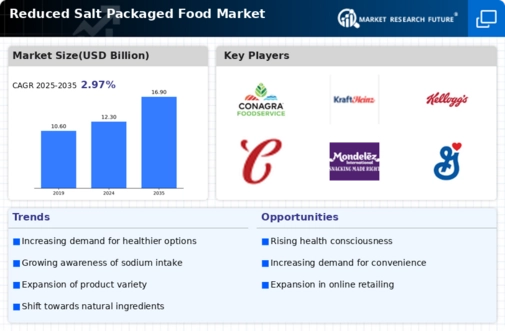Innovation in Food Technology
Innovation in food technology is playing a pivotal role in the growth of the Reduced Salt Packaged Food Market. Advances in food processing and preservation techniques have enabled manufacturers to create products that maintain flavor while reducing sodium levels. Techniques such as flavor enhancement through natural ingredients and the use of potassium chloride as a salt substitute are becoming more prevalent. This innovation not only satisfies consumer demand for healthier options but also addresses the challenge of taste, which has historically been a barrier to reduced salt products. As a result, the Reduced Salt Packaged Food Market is likely to see an increase in product offerings that appeal to both health-conscious consumers and those seeking enjoyable flavors.
Consumer Awareness and Education
Consumer awareness regarding the health risks associated with high sodium intake is a crucial driver for the Reduced Salt Packaged Food Market. Educational campaigns by health organizations and governments have effectively informed the public about the dangers of excessive salt consumption. This heightened awareness has led to a shift in consumer behavior, with many individuals actively seeking out reduced salt options. Market data indicates that a significant portion of consumers now reads nutritional labels, specifically looking for lower sodium content. This trend suggests that the Reduced Salt Packaged Food Market is likely to thrive as more consumers prioritize health and wellness in their food choices.
Health Regulations and Guidelines
The increasing implementation of health regulations and dietary guidelines by various governments appears to be a significant driver for the Reduced Salt Packaged Food Market. These regulations often aim to combat rising health issues such as hypertension and cardiovascular diseases, which are linked to high sodium intake. For instance, many countries have established recommended daily sodium limits, prompting food manufacturers to reformulate their products. This shift not only aligns with public health objectives but also caters to a growing consumer base that is increasingly aware of nutritional content. As a result, the Reduced Salt Packaged Food Market is likely to experience growth as companies adapt to these regulations, ensuring compliance while meeting consumer demand for healthier options.
Changing Demographics and Lifestyles
Changing demographics and lifestyles are influencing the Reduced Salt Packaged Food Market in notable ways. As populations age, there is a growing emphasis on health and wellness, particularly among older adults who are more susceptible to health issues related to sodium intake. Additionally, urbanization and busy lifestyles are leading consumers to seek convenient food options that do not compromise on health. This demographic shift is driving demand for reduced salt packaged foods that are both convenient and nutritious. Market trends indicate that younger consumers are also becoming more health-conscious, further expanding the target audience for the Reduced Salt Packaged Food Market. This evolving landscape suggests a promising future for products that cater to these changing consumer needs.
Rising Incidence of Lifestyle Diseases
The rising incidence of lifestyle diseases, particularly those related to dietary habits, is driving the Reduced Salt Packaged Food Market. Conditions such as hypertension, heart disease, and stroke are becoming more prevalent, leading consumers to seek healthier food alternatives. According to health statistics, a notable percentage of the population is now diagnosed with hypertension, which has prompted a shift in dietary preferences. Consumers are increasingly opting for reduced salt options as a preventive measure. This trend is further supported by the food industry, which is innovating to provide flavorful yet lower sodium products. Consequently, the Reduced Salt Packaged Food Market is positioned to expand as it aligns with the health-conscious choices of consumers.


















Leave a Comment